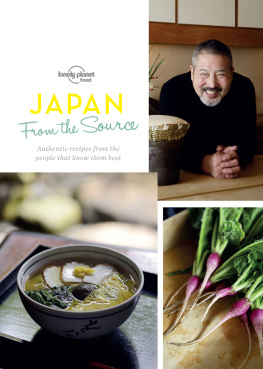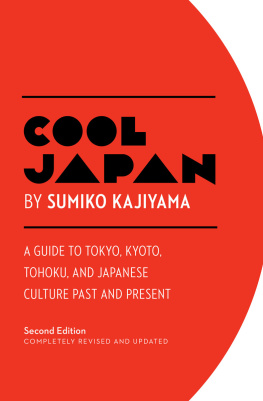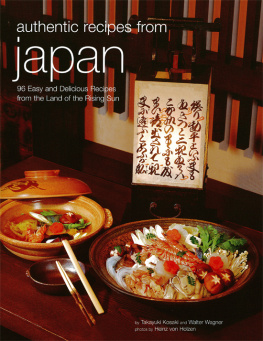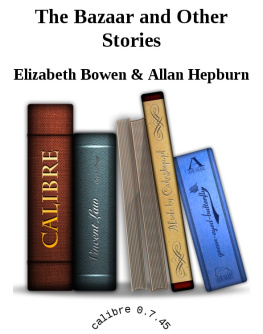Elizabeth Andoh - Kibo: Stories and Recipes from Japan’s Tohoku
Here you can read online Elizabeth Andoh - Kibo: Stories and Recipes from Japan’s Tohoku full text of the book (entire story) in english for free. Download pdf and epub, get meaning, cover and reviews about this ebook. year: 2012, publisher: Ten Speed Press, genre: Home and family. Description of the work, (preface) as well as reviews are available. Best literature library LitArk.com created for fans of good reading and offers a wide selection of genres:
Romance novel
Science fiction
Adventure
Detective
Science
History
Home and family
Prose
Art
Politics
Computer
Non-fiction
Religion
Business
Children
Humor
Choose a favorite category and find really read worthwhile books. Enjoy immersion in the world of imagination, feel the emotions of the characters or learn something new for yourself, make an fascinating discovery.

- Book:Kibo: Stories and Recipes from Japan’s Tohoku
- Author:
- Publisher:Ten Speed Press
- Genre:
- Year:2012
- Rating:3 / 5
- Favourites:Add to favourites
- Your mark:
- 60
- 1
- 2
- 3
- 4
- 5
Kibo: Stories and Recipes from Japan’s Tohoku: summary, description and annotation
We offer to read an annotation, description, summary or preface (depends on what the author of the book "Kibo: Stories and Recipes from Japan’s Tohoku" wrote himself). If you haven't found the necessary information about the book — write in the comments, we will try to find it.
Kibo: Stories and Recipes from Japan’s Tohoku — read online for free the complete book (whole text) full work
Below is the text of the book, divided by pages. System saving the place of the last page read, allows you to conveniently read the book "Kibo: Stories and Recipes from Japan’s Tohoku" online for free, without having to search again every time where you left off. Put a bookmark, and you can go to the page where you finished reading at any time.
Font size:
Interval:
Bookmark:
As a writer, I struggle with languagevocabulary and grammar, especially syntax. Much of my energy is spent balancing nuance of meaning and determining the best, most logical order in which to present and develop certain ideas. In my work, I must accommodate two languages that are wildly different from each other in verbal structure and written form: English and Japanese. An already challenging situation is made more difficult still because there is no single standard for transliteration. Academia, government circles, publishers, and print media all differ. Inconsistency is rampant.
Over the years, with abundant feedback from readers and volunteers who assist me in testing recipes, I have developed my own system to assist those familiar with English in pronouncing (unfamiliar) Japanese words. With each book I write, I review and revise. After all, language is a dynamic aspect of culture, constantly changing.
In this book, Kib, I continue to use accent marks. The one that appears over the o in kib is called a macron, or long mark. It represents an extended vowel sound (for which there is no English equivalent) that appears in some, but not all, Japanese words transliterated with the letter o. A macron is used to spell tfu, for example, but not miso.
I borrow the French accent mark for some e sounds because I want you to pronounce those ay. Ag is pronounced ah-gay, (g sounds are always hard, like good or great; soft g sounds are written with a j). Aburaag is fried tfu (and has nothing to do with age in the sense of a life span).
Next challenge: what should a particular ingredient, technique, or recipe be called? Use Japanese? Or English? I often find the need to combine the two. Shiso leaves and firm tfu are good examples of this. In the first instance, Japanese modifies English; in the latter example, it is reversed.
When there is a single, obvious, uncontested, accurate (or fairly accurate) English name for something, I have used that word: soy sauce, not shyu, for example. However, nothing is quite that simple. I find usukuchi shyu, the Japanese name for a pale-in-appearance-soy-sauce, a better choice than light-colored soy sauce to avoid mistaking this sauce for a lite seasoning. Usukuchi shyu is full strength in flavor and sodium, though it does not stain foods the way regular soy sauce does.
Though I continue to strive for accuracy and ease in identification, the choices I make are admittedly arbitrary. There may be some baffling inconsistencies. If you are having trouble locating an item, try a reverse language search. Go meiwaku wo okakshimasu ga Please, accept my sincere apologies for any inconvenience this may cause.
Yet another challenge: romanizing names of Japanese historical figures. Normally in Japan, the family name (surname) is first, followed by the given name. In that style, I am Andoh Elizabeth (not Elizabeth Andoh). Japanese historical personages who appear in English language texts are typically listed Japanese-style. I have followed suit with (seventeenth-century poet).
Kib is a collaborative work. I have beenand continue to bethe grateful recipient of advice, expertise, and assistance from a widely talented support group. I thank each and every one of the people listed below for their steadfast efforts. Oswa ni narimasu (I am in your debt). Indeed, I could never have done this without your individual and collective talents!
AT TEN SPEED PRESS AND RANDOM HOUSE:
My Kib team is large: an Advisory Council of dozens of volunteer recipe testers recruited through my newsletter and a smaller group that I have dubbed my Inner Circle who helped me vet and resolve a host of problems that arose along the waytaming wildcard recipes that stubbornly refused to yield consistent results, managing daunting administrative tasks (distributing, tracking, and collating assignments made to globally scattered council members), and affably acting as sounding board as I agonized, revised, and endlessly tweaked away. Thank you for staying the rough course with me.
A special note of thanks goes to Morrison Foerster, especially Michael A. Doherty (Partner, New York), Eric N. Roose (Partner, Tokyo), Michael H. Shikuma (Of Counsel, Tokyo), and Takeo Mizutani (Japanese Zeirishi [registered tax specialist], Tokyo) for patiently, professionally guiding me through the process of understanding, and then implementing, a charitable giving program.
Finally, no list of acknowledgments would be complete without including those who have provided me over the years with instruction and inspiration:
Font size:
Interval:
Bookmark:
Similar books «Kibo: Stories and Recipes from Japan’s Tohoku»
Look at similar books to Kibo: Stories and Recipes from Japan’s Tohoku. We have selected literature similar in name and meaning in the hope of providing readers with more options to find new, interesting, not yet read works.
Discussion, reviews of the book Kibo: Stories and Recipes from Japan’s Tohoku and just readers' own opinions. Leave your comments, write what you think about the work, its meaning or the main characters. Specify what exactly you liked and what you didn't like, and why you think so.






